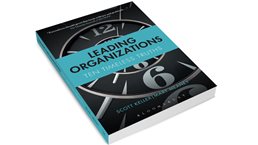In the book Leading Organizations,1 McKinsey senior partners Scott Keller and Mary Meaney address the ten most basic issues facing leaders: attracting and retaining talent, developing the talent you have, managing performance, creating leadership teams, making decisions, reorganizing to capture value quickly, reducing overhead costs for the long term, making culture a competitive advantage, leading transformational change, and transitioning to new leadership roles. This article, drawn from the book’s opening chapter, speaks to the first of these topics. Future articles will deal with reorganizing to capture maximum value quickly and with successfully transitioning to new leadership roles.
Stay current on your favorite topics
Why is talent important?
Superior talent is up to eight times more productive
It’s remarkable how much of a productivity kicker an organization gets from top talent. A recent study of more than 600,000 researchers, entertainers, politicians, and athletes found that high performers are 400 percent more productive than average ones.2 Studies of businesses not only show similar results but also reveal that the gap rises with a job’s complexity. In highly complex occupations—the information- and interaction-intensive work of managers, software developers, and the like—high performers are an astounding 800 percent more productive (Exhibit 1).

Suppose your business strategy involves cross-functional initiatives that would take three years to complete. If you took 20 percent of the average talent working on the project and replaced it with great talent, how soon would you achieve the desired impact? If these people were 400 percent more productive, it would take less than two years; if they were 800 percent more productive, it would take less than one. If a competitor used 20 percent more great talent in similar efforts, it would beat you to market even if it started a year or two later.
You get even more remarkable results comparing the productivity of the top and bottom 1 percent. For unskilled and semiskilled jobs, the top 1 percent are three times more productive; for jobs of middling complexity (say, technicians and supervisors), 12 times more. One person in the top 1 percent is worth 12 in the bottom 1 percent. For high-complexity jobs, the differential is so big it can’t be quantified.3
The late Steve Jobs of Apple summed up talent’s importance with this advice: “Go after the cream of the cream. A small team of A+ players can run circles around a giant team of B and C players.”4 Management guru Jim Collins concurred: “… the single biggest constraint on the success of my organization is the ability to get and to hang on to enough of the right people.”5
Would you like to learn more about People Analytics?
Great talent is scarce
The term “war for talent” was coined by McKinsey’s Steven Hankin in 1997 and popularized by the book of that name in 2001.6 It refers to the increasingly fierce competition to attract and retain employees at a time when too few workers are available to replace the baby boomers now departing the workforce in advanced economies.
Fast forward to the wake of the Great Recession, and the war for talent turned into the war for jobs. In economies gripped by financial crises, unemployment hit levels not seen since the early 1980s, so there was no shortage of applicants for many openings. When Walmart launched a new Washington, DC, store in 2013, for example, it received 23,000 applications for 600 positions.
It was harder to get entry-level work there than to be accepted by Harvard: 2.6 percent of Walmart applicants made it through, as opposed to 6.1 percent for the Ivy League university.7
Yet this didn’t end the war for talent. In medium- and higher-complexity positions, where stronger performers have an increasingly disproportionate bottom-line impact, the opposite was true. In those uncertain times, gainfully employed talent became less likely to change employers, so people who had an advantage going into the crisis had an even bigger one. Further, pressure to reduce HR costs made it harder to identify and attract the most talented people. Everything suggests that the war for talent will rage on. “Failure to attract and retain top talent” was the number-one issue in the Conference Board’s 2016 survey of global CEOs—before economic growth and competitive intensity (Exhibit 2). In more complex jobs, this will continue to be true as baby boomers (and their long experience) exit the workforce and technology demands more sophisticated skills.

A McKinsey Global Institute study8 suggests that employers in Europe and North America will require 16 million to 18 million more college-educated workers in 2020 than are going to be available. Companies may not be able to fill one in ten roles they need, much less fill them with top talent. Yet in advanced economies, up to 95 million workers could lack the skills required for employment. Developing economies will face a shortfall of 45 million workers with secondary-school educations and vocational training.9
Most companies don’t get it right
Since business leaders know that talent is valuable and scarce, you might assume that they would know how to find it. Not so (Exhibit 3). A whopping 82 percent of companies don’t believe they recruit highly talented people. For companies that do, only 7 percent think they can keep it.10 More alarmingly, only 23 percent of managers and senior executives active on talent-related topics believe their current acquisition and retention strategies will work.11

These leaders aren’t being humble—most companies just aren’t good at this stuff. Gallup reported that in a 2015 survey, more than 50 percent of respondents were “not engaged”; an additional 17.2 percent were “actively disengaged.”12 Related surveys report that 73 percent of employees are “thinking about another job” and that 43 percent were more likely to consider a new one than they had been a year earlier.13
The fact that the Baby Boomers’ decades of knowledge and experience are now leaving the workplace forever makes this state of play more unsettling. At the natural-resources giant BP, for example, many of the most senior engineers are called “machine whisperers” because they can keep important, expensive, and temperamental equipment online. If high-quality talent isn’t brought in to replace such people, the results could be catastrophic.
And the scarcer top talent becomes, the more companies that aren’t on their game will find their best people cherry-picked by companies that are. In future, this will be even more likely, since millennials are far less loyal to their employers than their parents were. The Bureau of Labor Statistics says that workers now stay at each job, on average, for 4.4 years, but the average expected tenure of the youngest workers is about half that.14 People often underestimate the cost of turnover: the more information- and interaction-intensive the job, the greater the threat to productivity when good people leave it, and the more time and money must be invested in searching and onboarding. And if competitors poach your talent, they get an insider’s understanding of your strategies, operations, and culture.
Talent matters, because its high value and scarcity—and the difficulty of replacing it—create huge opportunities when companies get things right. Let’s now turn to how they can do that.
What are the big ideas?
Focus on the 5 percent who deliver 95 percent of the value
Companies go through cycles of initiatives to improve their talent processes. Yet they reap only incremental improvements, and the vast majority of leaders report that their companies neither recruit enough highly talented people nor believe that their current strategies will work.
What do these leaders miss? Let’s consider American football. If you asked people who is the most highly paid player on a team, they would correctly say the quarterback, the key person in the vast majority of plays. People would probably say that the second most highly paid player was the running back or the wide receiver, since they work directly with the quarterback to advance the ball. These people are wrong. It’s the relatively unnoticed left tackle, who protects the quarterback from things he can’t see and could injure him.
Some employees disproportionately create or protect value, and not all of them are obvious. A navy, for example, should obviously ensure that it has the best and brightest people commanding fleets of nuclear submarines. Equally, however, it should ensure that it attracts superior talent to the role of the IT-outage engineer, who prevents catastrophes for the crew, the environment, and humanity. In a world of constrained resources, companies should focus their efforts on the few critical areas where the best people have the biggest impact. Start with roles, not processes (which create generic solutions that don’t meaningfully improve results) or specific people (who might help you in particular situations but don’t build institutional muscle).
Picking the right battles isn’t easy—you must understand the true economics of value creation in specific roles. That’s precisely why this can be one of your secret weapons in the war for talent.
Make your offer magnetic—and deliver
Leaders know the term “employee value proposition,” or EVP: what employees get for what they give. “Gives” come in many flavors—time, effort, experience, ideas. “Gets” include tangible rewards, the experience of working in a company, the way its leadership helps employees, and the substance of the work (Exhibit 4). If your EVP is truly stronger than the competition’s, you will attract and retain the best talent. But for three reasons, few companies have EVPs that meaningfully help them win this war:

Not distinctive. A typical human-resources department spends months determining what employees want—a great job, in a great company, with great leaders, and great rewards. HR then says the value proposition should deliver all this, so the EVP resembles that of every business that’s gone through the same process. It’s better for companies to stand out on one dimension while not ignoring the others. Work for Google if you want to face complex challenges, for Virgin if Richard Branson’s leadership stirs you, or for Amgen if you aspire to “defeat death.”
Not targeted. Although it’s fine to have an overall EVP, what matters most is a winning EVP for the 5 percent of roles that matter most. If data scientists are hugely important, for example, you’ll want an EVP that lets them invent things; offers a clear, rapid career progression; and helps them have a big impact.15
Unreal. An attractive EVP cooked up by HR and pushed through PR used to help secure the best talent. In the long term, however, this was always a losing proposition, since great people would quickly become disillusioned if the reality didn’t measure up. Today, however, talent won’t buy such promises at all. Employees are a more trusted source of information about working conditions than CEOs or HR chiefs.16 The same Internet and social media that help customers investigate product claims do the same thing for EVPs. Sites such as Glassdoor or Job Advisor offer peer ratings and reviews of what it’s really like to work for a company. Your EVP can’t be spin—it has to be distinctive, targeted, and real.
Technology will be the game changer
Michael Lewis’s book Moneyball17 pits the collective old-time wisdom of baseball players, managers, coaches, scouts, and front offices against rigorous statistical analysis in determining which players to recruit. Analysis wins, changing the game forever. Could the same be true for recruiting top talent?
When the National Bureau of Economic Research looked into this, it pitted humans against computers for more than 300,000 hires in high-turnover jobs at 15 companies. Human experience, instinct, and judgment were soundly defeated: people picked by computers stayed far longer and performed just as well or better.18 This wasn’t the only such finding. University of Minnesota professors analyzed 17 studies and found that hiring algorithms outperform humans by at least 25 percent. “The effect holds in any situation with a large number of candidates, regardless of whether the job is on the front line, in middle management, or (yes) in the C-suite.”19
Many leaders find this hard to stomach, but some companies are abandoning old ideas. The waste company Richfield Management, for example, uses an algorithm to screen applicants for character traits suggesting a tendency to abuse workers’ compensation. Claims have since dropped by 68 percent.20 After Xerox replaced its recruitment-screening process with an online test from Evolve, attrition declined by 20 percent.21
HR software systems from Oracle, SAP’s SuccessFactors, and Workday already gather information through sources such as LinkedIn to provide advanced warning when top talent may be thinking about jumping ship. At McKinsey, we used machine-learning algorithms to determine the three variables driving 60 percent of the attrition among our managers. Unexpectedly, all three are unrelated to pay, travel, or hours worked.
Although people analytics is a field still in its infancy, it’s gaining speed. In 2016, only 8 percent of companies reported that they were fully capable of using predictive modeling, but that was up from 4 percent in 2015.22 Leaders who don’t implement concrete plans to leverage technology in the war for talent will quickly fall behind. Yet machines alone won’t win it. In 1997, IBM’s Deep Blue computer thrashed grandmaster Gary Kasparov. Today, however, the world’s best chess players are neither computers nor humans, but human teams playing alongside computers.23 That will be true in business, too.

Leading Organizations: Ten Timeless Truths
How do I make it happen?
The new leader of a major US public institution had a mandate for change. Her department failed to meet the budget for five years. The press was having a field day with tales of incompetence, inefficiency, and bureaucracy gone mad. Morale was extremely low; key talent was leaving. The leader felt she knew what had to be fixed, but she didn’t have the talent. There was no quick fix—each division had its own approach to recruiting, and all were consumed with their immediate needs. The defectors were mostly the higher performers and specialist talent the organization wanted to keep.
1. Aspire
In the leader’s words, a team was commissioned to “fix the leaky bucket, and fill it with the finest stuff imaginable!” Core members from each division populated a task force to meet the challenge. Division leaders were told they were on the hook. The team first determined the talent requirements for the organization’s five-year plan. Two roles were especially important: general managers and data-analytics specialists. The team then coupled this demand view of talent with a supply view and identified the gaps. Senior leaders gave the team a mandate for bold action.
2. Assess
With the priorities established, the team took a deep dive into the current mess. What did recruits in each target segment care about? How did the institution compare with their other options? Why were people in key roles departing? Which current approaches were and weren’t working? Using interview techniques to get behind superficial answers, the team gathered qualitative data. Quantitative data were generated by predictive analytics algorithms that determine patterns and an analysis of how general managers spent their time.
The organization’s value proposition—the promise of interesting work, on-the-job development, and an attractive, flexible career path—turned out to be on target. However, the reality didn’t live up to it. When recruits called friends hired previously, they heard that the organization had gone “bureau-crazy.” Recruiters knew this, but their incentives were to get people through the door, so they hyped roles to meet short-term goals. Good talent left quickly, while others, happy with the security and relatively high pay, “quit and stayed,” remaining on the payroll but contributing little.
The team found that specialist candidates wanted a different value proposition: deeper technical development, opportunities for special projects, a more relaxed and informal environment, and freedom from administrative tasks.
3. Architect
The working team recommended two discrete career paths, for generalists and specialists. The role of general managers would be adjusted to let them play more of a coaching (rather than a coordination) role. For data analysts, the team proposed more relaxed, informal recruitment events on school campuses and a stronger referral program. Predictive analytics showed that the organization had significant weaknesses for some roles. Its leaders agreed to “segment of one” discussions with the highest performers to understand their issues and fix them quickly.
Analytics suggested that ten vital leaders might be on the verge of leaving. They were engaged to help reinvent the EVP for the general-manager role—an approach that not only produced better answers but also helped to promote retention. Further changes were proposed for the annual succession-planning process (for instance, focusing on pivotal roles) and the recruitment process, to make both more efficient.
4. Act
The leader and top team led from the front—for example, by personally attending the newly overhauled top-talent development programs—to communicate the importance of making the target EVP real and vibrant. She quickly became known for asking two questions in every performance dialogue: “what are your top five to seven priorities?” and “who are your top five to seven most talented leaders?” People learned that there should be a match between the answers. A talent office created to ensure progress reported on key metrics, such as time and cost to hire, as well as acceptance and attrition rates (overall and for key talent). These were studied with as much intensity as operational and financial metrics. To institutionalize transparency, the talent office developed an interactive dashboard with metrics on hiring, quality, fit, and efficiency.
5. Advance
The results appeared quickly: employee engagement shot up and attrition declined, especially among the most recent hires. Acceptance rates started improving, and employees became a powerful recruiting source. HR launched “choose who you want to work with” campaigns and made the most dynamic leaders and specialists “recruiting captains” for key campuses and career fairs.
Eighteen months later, after rising nearly 40 spots in the public sector’s Best Place to Work ranking, the organization found it easier to access talent, especially data scientists. Attrition dropped to historic lows, particularly in critical general-management and specialist roles. As a final sign of success, instead of trumpeting the organization’s downward spiral, headlines announced the bold new agenda and leadership.


